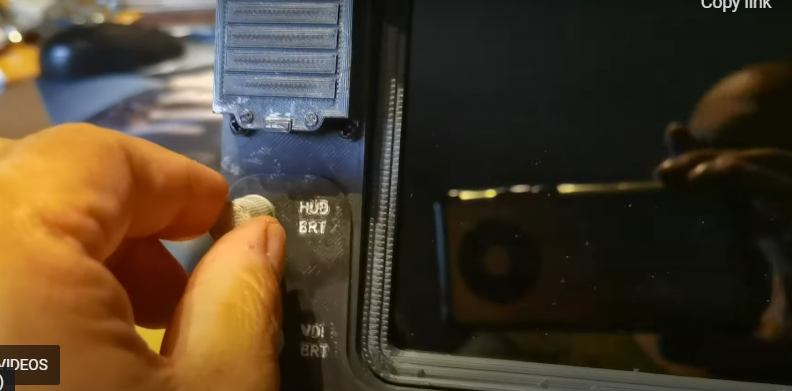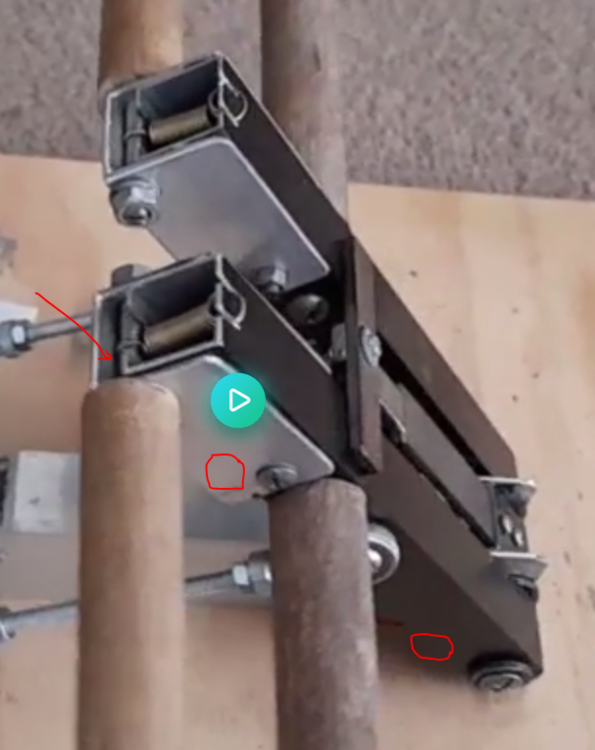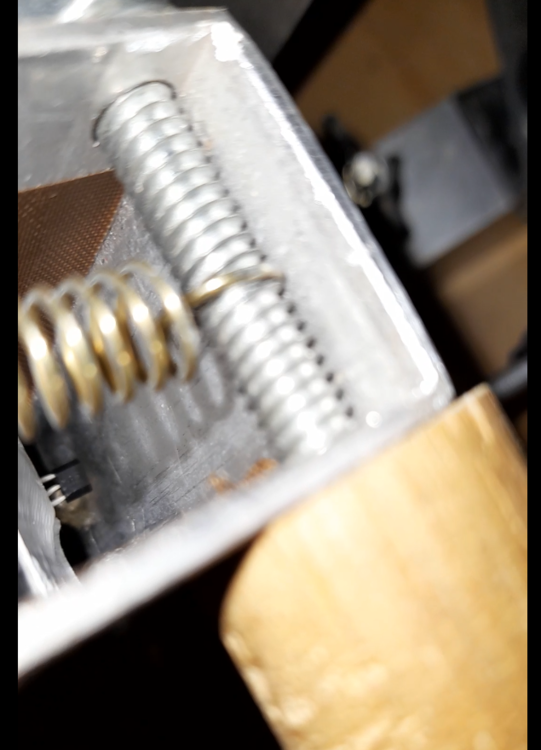

Dogmanbird
Members-
Posts
816 -
Joined
-
Last visited
Content Type
Profiles
Forums
Events
Everything posted by Dogmanbird
-

Virpil CM3 Base - Dis-assembly & Nyogel application Tutorial
Dogmanbird replied to HC_Official's topic in VIRPIL Controls
pg44a is excellent for anyone wanting a kind of hydraulic feel on pedals, collective and who is using a longer stick extension. It's best used sparingly and over a large contact area. From my experience it tolerates being under heavy pressure between two surfaces over long periods. Unlike 767, it doesn't get squeezed out and dry out as quickly, which will eventually change it's feel (needing a re grease after a while). However, I find it too strong without an extension. -
Hi Xupicor, I have have the warthog joystick / throttle and bought them around 2014. I haven't tried updating firmware so you are possibly right that it's been fixed since. Back then I was unable to remove it even though the software showed that it was set to 0. A colleague's stick of similar age did the same thing.
-
Hi Dishdoggie, Any chance you've increased the axis filtering somehow (maybe to reduce jitter?) I'm not familiar with virpil's software but I imagine it offers this as an option. If it's too high it will add some latency.
-
I have same issue both with my own heli and for the AI, just since the last couple of DCS updates
- 31 replies
-
- minigun problem
- trigger problem
-
(and 2 more)
Tagged with:
-
Hi, has anyone recently received any Virpil orders valued at less than $1000, to Aus without being held at customs and affected by the 35% tax? Cheers
-
Thanks for the feedback. I much prefer that too. I have 767 and 44a at my work for use in tripod heads that use multiple disks as drag (not true fluid heads). eventually I need to replace the grease. If the equipment on the tripod is light then it's okay, but heavy equipment starts to stick. It also may be changes in humidity and temperature that affects it over time. btw there is a different brand of 44a that is cheaper using and the same makeup(can't remember the name). both seems to last the same. It would be interesting to try it , especially if it's a lot cheaper than 44 and 767. it's those ultra tiny movements that they allow which feels awesome when first applied. However 44 will almost rip the stick off the base if needing to move it quickly, though imo it feels the nicest of the two for very precise movements.. I haven't yet found a grease type solution that suits both rapidly swinging the stick to it's extremes for some space games and helicopters in sims. The disk sandwich you've seen in the video is the best I've found so far, though I doubt it would appeal to most folk
-
thank you fellow doggie
-
^ This is a great thread and I love seeing the creativity! Huey is my fave of them all in dcs the vids are about a year old or more. I've made small changes since but basically still the same. Some butchered vkb stuff attached to ebay handbrake and bunnings parts for pedals. https://imgur.com/f5zvpaH https://imgur.com/HxIyWSj https://imgur.com/uxfMnwg
-
https://discord.gg/szqaJE7
-
If you haven't yet had any luck via winwing directly, have you tried the discord server? (I know Discord's a bit messy and confusing). If you can post your issue in the winwing channel, the active representative there would probably be able to assist with getting you some parts if happy to install yourself.
-
I'm enjoying watching your progress on these when I saw this, I thought to myself "is he filming it with his nvidia founders edition gpu??" nullnull
-
Thank you Les, will have a read through.
-
Thank you. I was curious if it was a servo and arduino combo driving them. re the help forums - yeah I could imagine that. It seems to go with the territory sometimes
-
did you find it gave a non-uniform feel through the range, or just over dampened and slow to center (or did not perfectly center at all) for your liking?
-
Hi Les - I meant to ask, do your analogue gauges function? If so, can you talk a bit about it? Cheers
-
Hi lesthegrngo, yes the brakes work. There's a hall sensor (red circled) glued to the back of each black pedal arm and a magnet glued to the inside of the unpainted alloy that the wooden brake arm is screwed to. The hall sensor and magnet for the rudder movement is glued behind the right pedal arm, down close to where everything pivots. Again using pro micro board. I experimented with pendular pedals too, but I still needed to move my heel about when pushing. VKB's pedals feel nice as the pivot point is near the heel, but they don't offer much travel and no toe braking. For me the most comfortable setup is having the pedal pivot point beneath the feet and under the ankle, with arm coming up through the floor. Unfortunately I don't have the space for it so had to compromise null null
-
Love your cockpit project! I have a set of the same pedals. I agree, they're a little plasticky, sloppy and flimsy. Not sure there's a lot we can do for that, but they do work. I was also using them for choppers as well as planes. I put bars on the heel rests so I could put my heels on the floor and push with my toes. I removed the center spring and replaced the processor board with a arduino/promicro, mainly because the original board has a centre dead zone that you can't fully remove (regardless of what the setup software indicates), which is not ideal for choppers. I have limited space and i needed something narrower. I also wanted to quickly switch from choppers to planes with self centering. I experimented a bit with a few diy ideas and it resulted in the one at the bottom. It's not pretty but works and I'm still using it after nearly 2 years. video here https://i.imgur.com/uxfMnwg.mp4 null
-

AV8 3d printed nozzle lever for warthog throttle
Dogmanbird replied to FoxDelta's topic in Home Cockpits
@Thanatos31 Looks great -
Hi Tony. If you'd like a screenshot of where to find it I can post some pics. Part of the reason I mentioned it above, is because some sticks and rudders don't allow the complete removal of the centre deadzone, even though the config software says it's set to minimum or none ala thrustmaster / logitech and saitek. Fallout9 kindly tested the cheaper vkb nxt / evo bases and confirmed they can completely remove it (thanks) i'm definitely not an authority on sticks and helicopters, but should any of the following be useful ; For anyone not that familiar with dead zones / deadzones / dz - A centre deadzone exists on almost every joystick one can buy (and rudder pedals), it is generally stored in the sticks firmware and can usually be modified by the sticks software. There's a small spot in the joystick's very centre position (and possibly at full joystick deflection) that doesn't register movement - hence a "dead zone". It's only a few degrees in size, it doesn't respond to stick movement and one of it's tasks is to dampen/mask the noise that's output from the joysticks axis sensor (whichever type of sensor is used) and make the stick appear stationary. Regardless of the method used to sense movement, there's always some noise (random jittering of the values output from the sensor), which is unwanted and can affect the aircraft's controls. For cheap joysticks, it's also used to help hide deficiencies in the stick design, such as the flex in a plastic construction that might cause unwanted movement around center. The vkb Config software will allow you to set a deadzone to 0, instead of it's default value of maybe 3 or 5 or 10 etc. and does totally remove the deadzone. VKB sets this to something above 0 by default like most manufacturers to mask the noise and make the joystick appear stationary when within the "deadzone". The larger the number, the greater the range of movement that will behave as a deadzone. For folk not familiar with helicopters - (generally) the cyclic control and torque (or anti torque) control whish basically the rudder, have no absolute centre position. What could be considered center is affected by, and based on, environmental conditions, speed and probably other things like aircraft /cargo weight distribution at the time as it is with planes, but maybe more so. The controls tend to stay where you leave them when pilot removes hands, particularly if hovering or travelling slow, though they may move towards centre if travelling at higher speeds due to air pressure on the blades and fuselage. Helicopters require very small degrees of movement from the controls to maintain stability or it's course. If the stick happens to pass through a deadzone then the stick becomes unresponsive, so removing it is beneficial. The heli pilot is making constant micro stick movements, relative to the stick movements used for a plane. If using a long joystick extension, which allows for finer inputs (desirable for heli flying), it has the effect of magnifying the deadzone area if one is present. If someone's not flying helicopters, and mainly flying planes, it's not necessary to remove the deazone from the joystick (and rudder pedals). In addition to deadzones - If required, the joystick's microprocessor can remove the noise / jitter somewhat by applying a filter that takes a few axis sensor readings and calculates the average of those readings, then outputs that to the game. (this can be set in vkb config) This is usually turned on by default. The more sensor readings per calculation, the less jitter, resulting in a smoother output. Unfortunately, if this is set to include many readings per calculation, it takes longer to calculate the average. If too long, the game then noticeably lags behind your joystick movements (input latency). Manufacturers tend to set this filter to include only two or three readings per calculation to keep the lag to a minimum. MSFS2020 appears to do the above within the game itself, with what appears to be many sensor readings and this can't be completely disabled (from what I can see). This adds to the joysticks own lag. Therefore MSFS always feels a bit laggy regardless of how the joysticks built-in filter is configured. DCS doesn't appear to apply any filtering which imho is great. Lag can make it more difficult to hover the helicopter and tends to make the user overcorrect. Lag / latency is not such a problem when flying planes and often folk aren't even aware of it until it's pointed out. Having said all that, people have been enjoying flying helicopters with their cheaper or expensive sticks (and rudders) even with deadzones. It just becomes more apparent when needing to fly or hover between objects with minimal space, remain close to the ground at high speed, cargo drops, land quickly and smoothly within a very small space and right onto a target without fluffing around too much etc.
-
didn't know about the haptics and electronic detents. sounds exciting
-

Super Taurus with F-16 Throttle? It can be done...but should it?
Dogmanbird replied to DirtiByrd's topic in Winwing
Hi Saca111, Thanks for the suggestion. I haven't read right through it but assume it's to build a button matrix with the arduino? I already had the two koolertrons so was hoping to to make use of them. I'm not sure if they output ps2, but if they do I may be able to use a promicro as a translator to game buttons. If koolertron doesn't use ps2 output, maybe I can use a shield. Saca111 - have you ever tried fitting a usb shield to a promicro or leonardo? Cheers -

Super Taurus with F-16 Throttle? It can be done...but should it?
Dogmanbird replied to DirtiByrd's topic in Winwing
ok, thanks for the reply -
I bought a tube of pg44 to use on a warthog stick and the gunfighter III clutches. It felt fantastic immediately after applying, but it's consistency slowly changes, possibly drying out a little? After 6 months to a year some sticking had returned. I guess if happy to clean and reapply when necessary, it's no problem





